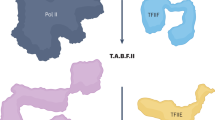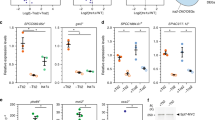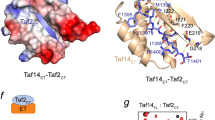Abstract
Eukaryotic transcriptional activators function, at least in part, by promoting assembly of the preinitiation complex1,2,3, which comprises RNA polymerase II and its general transcription factors (GTFs). Activator-mediated stimulation of the assembly of the preinitiation complex has been studied in vitro but has been relatively refractory to in vivo analysis. Here we use a DNA-crosslinking/immunoprecipitation assay to study in living cells the first step in the assembly of the preinitiation complex, the interaction between the TATA-box-binding protein (TBP) and its binding site, the TATA box. Analysis of a variety of endogenous yeast genes, and of a series of activators of differing strength, reveals a general correlation between TBP binding and transcriptional activity. Using mutant yeast strains, we show that Mot1 prevents the binding of TBP to inactive promoters and that activator-mediated stimulation of TBP binding requires additional GTFs, including TFIIB and Srb4. Taken together, our results indicate that TBP binding in vivo is stringently controlled, and that the ability of activators to stimulate this step in the assembly of the preinitiation complex is a highly cooperative process involving multiple transcription factors.
This is a preview of subscription content, access via your institution
Access options
Subscribe to this journal
Receive 51 print issues and online access
$199.00 per year
only $3.90 per issue
Buy this article
- Purchase on SpringerLink
- Instant access to full article PDF
Prices may be subject to local taxes which are calculated during checkout





Similar content being viewed by others
References
Roeder, R. G. The role of general initiation factors in transcription by RNA polymerase II. Trends Biochem. Sci. 21, 327–335 (1996).
Orphanides, G., Lagrange, T. & Reinberg, D. The general transcription factors of RNA polymerase II. Genes Dev. 10, 2657–2683 (1996).
Ptashne, M. & Gann, A. Transcriptional activation by recruitment. Nature 386, 569–577 (1997).
Selleck, S. B. & Majors, J. In vivo “photofootprint” change at sequences between the yeast GAL1 upstream activating sequence and “TATA” element required activated GAL4 protein but not a functional TATA element. Proc. Natl Acad. Sci. USA 85, 5399–5403 (1988).
Giardian, C. & Lis, J. T. Dynamic protein-DNA architecture of a yeast heat shock promoter. Mol. Cell. Biol. 15, 2737–2744 (1995).
Chen, J., Ding, M. & Pederson, D. S. Binding of TFIID to the CYC1 TATA boxes in yeast occurs independently of upstream activating sequences. Proc. Natl Acad. Sci. USA 91, 11909–11913 (1994).
Strahl-Bolsinger, S., Hecht, A., Luo, K. & Grunstein, M. SIR2 and SIR4 interactions in core and extended telomeric heterochromatin in yeast. Genes Dev. 11, 83–93 (1997).
Orlando, V. & Paro, R. Mapping polycomb-repressed domains in the bithorax complex using in vivo formaldehyde cross-linked chromatin. Cell 75, 1187–1198 (1993).
Lue, N. F., Buchman, A. R. & Kornberg, R. D. Activation of yeast RNA polymerase II transcription by a thymidine-rich upstream element in vitro. Proc. Natl Acad. Sci. USA 86, 486–490 (1989).
Ma, J. & Ptashne, M. Deletion analysis of GAL4 defines two transcriptional activating segments. Cell 48, 847–853 (1987).
Auble, D. T. et al. Mot1, a global repressor of RNA polymerase II transcription, inhibits TBP binding to DNA by an ATP-dependent mechanism. Genes Dev. 8, 1920–1934 (1994).
Davis, J. L., Kunisawa, R. & Thorner, J. Apresumptive helicase (MOT1 gene product) affects gene expression and is required for viability in the yeast Saccharomyces cerevisiae. Mol. Cell. Biol. 12, 1879–1892 (1992).
Collart, M. A. The NOT, SPT3, and MOT1 genes functionally interact to regulate transcription at core promoters. Mol. Cell. Biol. 16, 6668–6676 (1996).
Madison, J. M. & Winston, F. Evidence that Spt3 functionally interacts with Mot1, TFIIA, and TATA-binding protein to confer promoter-specific transcription control in Saccharomyces cerevisiae. Mol. Cell. Biol. 17, 287–295 (1997).
Shen, W.-C. & Green, M. R. Yeast TAFII145 functions as a core promoter selectivity factor, not a general coactivator. Cell 90, 615–624 (1997).
Thompson, C. M., Koleske, A. J., Chao, D. M. & Young, R. A. Amultisubunit complex associated with the RNA polymerase II CTD and TATA-binding protein in yeast. Cell 73, 1361–1375 (1993).
Kim, Y.-J., Bjorklund, S., Li, Y., Sayre, M. H. & Kornberg, R. D. Amultiprotein mediator of transcriptional activation and its interaction with the C-terminal repeat domain of RNA polymerase II. Cell 77, 599–608 (1994).
Nikolov, D. B. et al. Crystal structure of a TFIIB–TBP–TATA-element ternary complex. Nature 377, 119–128 (1995).
Tang, H., Sun, X., Reinberg, D. & Ebright, R. H. Protein–protein interactions in eukaryotic transcription initiation: structure of the preinitiation complex. Proc. Natl Acad. Sci. USA 93, 1119–1124 (1996).
Bryant, G. O., Martel, L. S., Burley, S. K. & Berk, A. J. Radical mutations reveal TATA-box binding protein surfaces required for activated transcription in vitro. Genes Dev. 10, 2491–2504 (1996).
Lee, M. & Struhl, K. Aseverely defective TATA-binding protein-TFIIB interaction does not preclude transcription activation in vivo. Mol. Cell. Biol. 17, 1336–1345 (1997).
Thompson, C. M. & Young, R. A. General requirement for RNA polymerase II holoenzymes in vivo. Proc. Natl Acad. Sci. USA 92, 4587–4590 (1995).
Koh, S. S., Ansar, A. Z., Ptashne, M. & Young, R. A. An activator target in the RNA polymerase II holoenzyme. Mol. Cell 1, 859–904 (1998).
Lin, Y. S. & Green, M. R. Mechanism of action of an acidic transcriptional activator in vitro. Cell 64, 971–981 (1991).
Burley, S. K. & Roeder, R. G. Biochemistry and structural biology of transcription factor IID (TFIID). Annu. Rev. Biochem. 65, 768–799 (1996).
Verrijzer, C. P. & Tjian, R. TAFs mediate transcriptional activation and promoter selectivity. Trends Biochem. Sci. 21, 338–342 (1996).
Koleske, A. J. & Young, R. A. The RNA polymerase II holoenzyme and its implications for gene regulation. Trends Biochem. Sci. 20, 113–115 (1995).
Halle, J.-P. & Meisterernst, M. Gene expression: increasing evidence for a transcriptosome. Trends Genet. 12, 161–163 (1996).
Acknowledgements
We thank R. Young, M. Grunstein, J. Thorner and J. Majors for yeast strains, J. Ma for plasmids, and K. Struhl for discussion and for communicating unpublished results. This work was supported in part by a grant from the NIH to M.R.G. M.R.G. is an investigator of the Howard Hughes Medical Institute.
Author information
Authors and Affiliations
Corresponding author
Rights and permissions
About this article
Cite this article
Li, XY., Virbasius, A., Zhu, X. et al. Enhancement of TBP binding by activators and general transcription factors. Nature 399, 605–609 (1999). https://doi.org/10.1038/21232
Received:
Accepted:
Issue Date:
DOI: https://doi.org/10.1038/21232
This article is cited by
-
The Mediator kinase module enhances polymerase activity to regulate transcriptional memory after heat stress in Arabidopsis
The EMBO Journal (2024)
-
Transcription regulation by the Mediator complex
Nature Reviews Molecular Cell Biology (2018)
-
Mechanisms of Mediator complex action in transcriptional activation
Cellular and Molecular Life Sciences (2013)
-
Distinct role of Mediator tail module in regulation of SAGA-dependent, TATA-containing genes in yeast
The EMBO Journal (2012)
-
Transcriptional activators and activation mechanisms
Protein & Cell (2011)
Comments
By submitting a comment you agree to abide by our Terms and Community Guidelines. If you find something abusive or that does not comply with our terms or guidelines please flag it as inappropriate.



